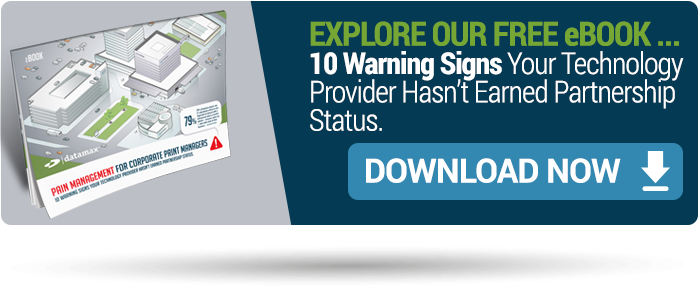
“Changing out vendor solutions means dealing with challenges and attitudes I’d rather avoid... There's got to be a better way.” — Kenneth V., CIO
Renowned business leaders often exhibit oddball behavior with specific strategic intent. As an example, Michael O’Leary, CEO of Ryanair Airlines, dressed as the pope when Ryanair opened up a new route to Rome for the simple reason of eliciting more publicity.
There’s a method to their madness.
However, a new solution or new vendor onboarding process brings internal anxiety. Changes to print and workflow habits, paired with the unfamiliarity with a new technology partner, calls for a specific Change Management Methodology to incite collaboration, produce desirable results, and remove all fear associated with implementation.
There’s either a method, or there’s madness.
A reputable technology partner thinks bigger, and never forgets the need for a change management plan. Those working with a key account understand the fear – or even resistance – that accompany change of any kind across their landscape of printers and MFPs. Whether it’s removing that beloved desktop printer, or enabling print restrictions on certain devices, a Change Management Methodology should be at work behind the scenes.
Often, changing vendors can involve challenges you'd rather avoid. There's got to be a better way, right?
Discover Change Collaboratively
Technology transformation begins with an assessment. When companies face moments where the need to take action is clear, a reputable partner will take first steps by analyzing document workflow, key document and information-based processes, and providing recommendations. But the process must be collaborative in nature.
A few components ensure a successful assessment:
- Stakeholder Engagement – active executive management and stakeholder engagement and support during the assessment.
- Clarity of Objectives – clearly stated assessment objectives and assessment methodology
- Holistic Approach – comprising workflow, documents/print, and network infrastructure.
- Contextual Focus – discovery assessments conducted in convert with client’s vertical industry
- Cooperate Investment – time and resources are contributed by both partner and client
- Information Access – Freedom to access/acquire associated technology-related data regarding assets, performance and cost
- Assessment Deliverable – detailed findings and prioritization of determined needs offered in formal graphical report format.
Implement Change Collaboratively
At its core, change management is an approach of shifting people, teams and organizations from one state of mind to a desired future state of mind. This process ensures that people are proactively engaged to understand, accept and embrace mission critical changes around the office.
A successful technology roll-out of any kind (Print Management, Network Management, or just a mid-volume MFP, etc.) depends upon having a proper change management strategy, and communicating the process’ value to the employees affected by it. Such components include:
1. Strategy
Communicating a certain strategy answers the “WHY” question for the technology change at hand (or more specifically, “Why are you relocating my desktop printer?”) and challenges employees to “THINK” about the value of smarter technology initiatives, as well as provides an opportunity to align with pre-existing corporate stewardship and green initiatives.
2. Promotion
This provides a campaign of collateral and communications to help ease the transition to a more responsible way of printing by promoting change as a benefit not only to organizations as a whole, but on a personal level as well. A partner must promote the change so your team – directly affected by it - feel like they are a part of it.
It could be something as simple as an ongoing email exchange with a contact, reinforcing the value that your partner aims to provide.
3. Feedback
This helps identify program and application blind spots, solicits performance information and grass-roots recommendations for ongoing project optimization. It could be a feedback survey. It could come up organically during a regularly partnership review. But it’s to everyone’s advantage that the end-user's voice is heard throughout and beyond the technology roll-out.
Educate Collaboratively
Continuing education is a magic potion for fear associated with new technology.
Your partner should commit from the beginning to develop a training schedule with end users. Make sure that your key account manager sets up an initial training schedule prior to onboarding. A few keys to successful training:
- On-site training should include full equipment overview, basic and advanced operations, as well as troubleshooting and maintenance tips.
- A team of “full-time” dedicated, experienced technology trainers on an “as needed” basis following the initial training
- Training staff should ensure account users overcome new technology anxiety, acquire full functionality familiarization, and enhance technology productivity.
In working with your partner, how successful is implementation of new technology? Is there a Change Management Methodology? Or just madness? Are you anxious to eliminate onboarding anxiety? The Datamax Key Account Program ensures a fully tested and fully functional discovery and onboarding process that will take the fear out of your fleet management.
To learn more about the collaborative approach that goes into onboarding under the Datamax Key Account Program, schedule a meeting with one of our program consultants!
Robert H. Caldwell is the Vice President of Marketing at Datamax Inc. He can be reached at (800) 633-1526.


